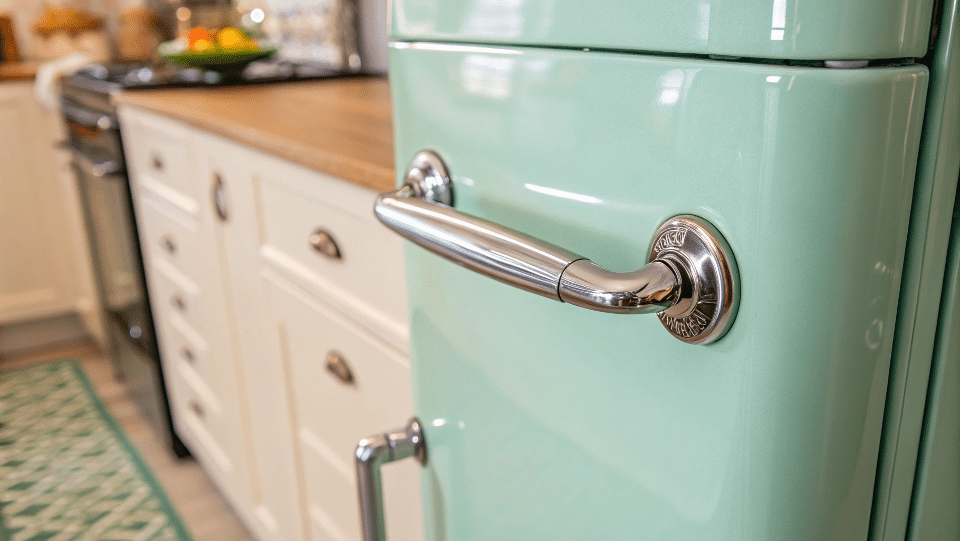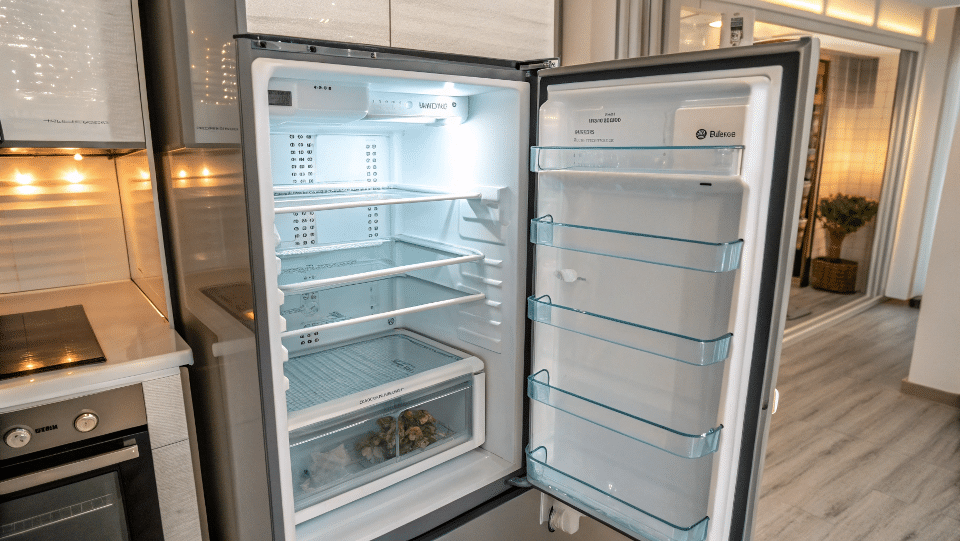Struggling to find a fridge with personality that doesn't guzzle energy? You want vintage style, but you need modern reliability. Is it possible to get both in one appliance?
Yes, modern retro fridges masterfully blend iconic 1950s design with today's best technology. They offer the charming aesthetic of curved silhouettes and chrome details, but are built with energy-efficient compressors, frost-free systems, and practical interiors. You get the look without the liability.
I’ve spent my entire career in the refrigerator industry. I started on the factory floor and eventually built my own successful company. I helped clients like Alex, a brand owner in Lebanon, navigate the world of sourcing and selling these beautiful appliances. He wants to be the top seller of retro fridges, and to do that, you have to understand what makes a great one. It’s about more than just a pretty color. The real magic is in the details, where classic design meets unseen modern power. Let's dive into what you need to know.
What Design Details Truly Define a Retro Fridge?
You want to offer customers an authentic vintage vibe, not a cheap knock-off. But many "retro" appliances miss the mark. How do you ensure your products have that genuine charm?
The secret is in the specific details. True retro authenticity comes from using rounded corners, stamped metal bodies, and solid, polished chrome handles. The right color palette, with classic pastels like mint green or cream, is also crucial for creating that sought-after nostalgic feeling.

When I walk through a factory, I can spot a quality retro fridge immediately. It’s all about the materials and the manufacturing process. A customer might not know why one fridge feels premium and another feels cheap, but they can feel the difference. For brand owners like Alex, specifying these details with your OEM supplier is non-negotiable. The body should be made from stamped steel, not molded plastic. This gives it the weight and solidity of a classic appliance. The touchpoints are just as important. The handle should be made from a heavy zinc alloy or steel with a chrome finish, not chrome-painted plastic. It's the first thing a customer touches.
Here’s a breakdown of what separates a high-quality product from a low-cost alternative.
Key Retro Design Specifications
| Component | High-Quality Specification | Low-Cost Alternative | Impact on Customer Perception |
|---|---|---|---|
| Body/Shell | Stamped Steel Sheet | Molded Plastic Shell | Steel feels durable and authentic; plastic feels cheap and fragile. |
| Handle | Polished Chrome Zinc-Alloy | Chrome-Plated Plastic | A heavy, cool-to-the-touch metal handle signals premium quality. |
| Logo/Branding | Raised Metal Badge | Printed Sticker or Decal | A metal badge looks permanent and classic, part of the design. |
| Paint Finish | High-Gloss Automotive Paint | Standard Powder Coating | A deep, glossy finish enhances the curves and looks luxurious. |
Getting these details right creates a product that not only looks good online but also impresses customers in person, building trust and justifying a premium price.
What Modern Tech Should You Look for Inside a Retro Fridge?
A beautiful fridge is pointless if it runs loudly, drives up electricity bills, or needs constant defrosting. Customers expect modern performance. How do you deliver that inside a vintage-style shell?
Focus on the core technology inside. A top-tier retro fridge must have a quiet, energy-efficient inverter compressor, a reliable frost-free system, and bright, modern LED lighting. Adjustable glass shelves and smart door storage are also key features that deliver the convenience today's users demand.

The outside sells the dream, but the inside keeps the customer happy. From my experience building refrigerators, the single most important component is the compressor. An old-style, single-speed compressor is cheap, but it's noisy and wastes energy. A modern inverter compressor, on the other hand, runs quietly and adjusts its speed to maintain a constant temperature, saving a lot of money on electricity bills over time. This is a huge selling point. Another critical feature is a frost-free system. Nobody wants to go back to the days of manually chipping ice out of the freezer. This is a standard expectation now, and leaving it out makes a fridge feel genuinely old, and not in a good way. Finally, think about the user experience. Bright LED lighting makes everything easy to see, and adjustable glass shelves give users the flexibility to store items of all sizes.
Here’s a simple comparison of modern standards versus outdated technology.
Modern vs. Outdated Fridge Technology
| Feature | Modern Standard | Outdated Technology | Benefit to the User |
|---|---|---|---|
| Compressor | Inverter Compressor | Single-Speed Compressor | Quieter operation, lower energy bills, more stable temperature. |
| Defrost System | Frost-Free (Automatic) | Manual Defrost | Saves time and effort; prevents ice buildup and freezer burn. |
| Lighting | LED Strips/Bulbs | Incandescent Bulb | Brighter, uses less energy, lasts much longer. |
| Shelving | Spill-Proof Glass | Wire Racks | Easy to clean, looks more modern, prevents small items from falling. |
When you source your products, insisting on these modern features ensures your retro fridges perform as wonderfully as they look.
How Can You Balance Quality and Cost for Your Retro Fridge Brand?
You need to set a competitive price to win sales. But cutting costs too much can lead to poor quality, angry customers, and a damaged brand reputation. Where is the smart place to invest?
Be strategic with your budget. Invest heavily in the components customers see and touch every day, like solid metal handles and a flawless paint finish. Never compromise on core performance parts like the compressor or the door seals. This approach ensures perceived value and long-term reliability.

This is the toughest challenge for any brand owner. When I work with clients, I tell them to think like a customer. What makes the biggest impression? From my years in the factory, I've learned that you can't cut corners on everything equally. The compressor is the heart of the fridge; a cheap one will lead to failures and warranty claims that will kill your profit and reputation. The same goes for door seals. A poor seal means the compressor works harder, wasting energy and wearing out faster. These are your non-negotiable quality points. However, you can be more flexible with other parts. For example, the specific grade of plastic used for an interior crisper drawer might not be as critical, as long as it's durable and food-safe. It's a balance. You want to create a product that feels premium without over-engineering parts the customer will never notice.
Here is a checklist to guide your decisions when talking with suppliers.
Strategic Cost-Balancing Checklist
| Area | Key Consideration | Red Flag to Watch For |
|---|---|---|
| Core Performance | Use a reputable brand compressor. Ensure insulation foam is thick and evenly distributed. | Unbranded components. Thin walls that feel flimsy. |
| Exterior Touchpoints | Invest in real metal handles and a high-quality, multi-layer paint job. | Plastic parts that are painted to look like metal. Visible paint drips or "orange peel" texture. |
| Interior Materials | Use food-grade, durable plastics. Glass shelves should have polished edges. | Flimsy, thin plastic that cracks easily. Rough edges on shelves or drawers. |
| Quality Control | Have an independent inspection done at the factory before shipping. | Supplier is resistant to third-party QC checks. Higher than 2% defect rate on initial samples. |
By being smart about where you allocate your costs, you can build a high-quality retro fridge that customers love and that supports a healthy business model.
Conclusion
A great retro fridge delivers both nostalgic style and modern performance. Focus on authentic design details and reliable internal technology to build a brand your customers will proudly display and use.

